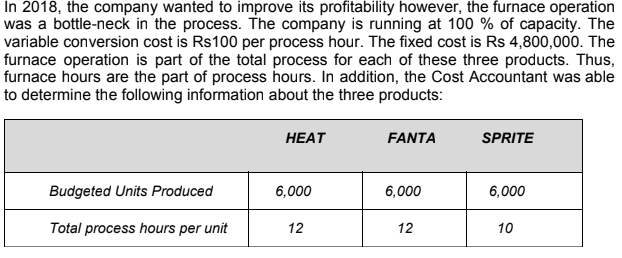Answered step by step
Verified Expert Solution
Question
1 Approved Answer
Please do all questions!!! Please try and understand the context it has a case study then questions.It manufactures three types of Acs - Heat ,
Please do all questions!!! Please try and understand the context it has a case study then questions.It manufactures three types of Acs - Heat , Fanta and Sprite.I don't know more information about this question






COLA' is a manufacturer, retailer, and installer of a Split AC for industrial buyers. It started business in 2001 and its market segment has been low to medium level groups. The Company produces three types of ACs - COLA, FANTA and SPRITE grade. Until recently, its business model has been based on selling high volumes of a standard AC, brand name 'HEAT', with a very limited degree of customer choice, at low profit margins. 'COLA's current control system is focused exclusively on the efficiency of its manufacturing process and it reports monthly on the following variances: material price, material usage and manufacturing labour efficiency. 'COLA' uses standard costing for its manufacturing operations. In 2018, 'COLA' employed 20 teams, each of which is required to install one of its 'HEAT' AC per day for 350 days a year. The average revenue per 'HEAT' AC installed is Rs 36,000. 'COLA' would like to maintain this side of its business at the current level. The 'HEAT' installation teams are paid a basic wage, which is supplemented by a bonus for every AC, they install over the yearly target of 350. The teams make their own arrangements for each installation and some teams work seven days a week, and up to 12 hours a day, to increase their earnings. 'COLA' usually receives one minor complaint each time a 'HEAT' AC is installed and a major complaint for 10% of the 'HEAT' AC installations. In 2016, COLA' had launched the new AC, brand name 'HEAT-Cool'. This AC is aimed at high-level corporates and it offers a very large degree of choice for the customer and the use of the highest standards of materials, appliances, and installation. 'COLA' would like to grow this side of its business. A 'HEAT-Cool' AC retails for a minimum of Rs100,000 to a maximum of Rs 500,000. The retail price includes installation. In 2017 the average revenue for each 'HEAT-Cool' AC installed was Rs 300,000. Currently, COLA' has 7 teams of 'HEAT-Cool' AC installers and they can install up to 240 AC a year per team. These teams are paid salaries without a bonus element. 'COLA' has never received a complaint about a 'HEAT-Cool' AC installation. 'COLA's business is generated from repeat orders, recommendations, and local press advertising. It employs three sales executives who earn an annual salary of Rs 300,000 each. It offers a six-month money back guarantee and this has to be fulfilled for 1% of its installations. 'COLA' has always been in profits but was shocked to see that in its results in 2017 it only earned 0.2% net profit on its turnover. In 2018, the company wanted to improve its profitability however, the furnace operation was a bottle-neck in the process. The company is running at 100 % of capacity. The variable conversion cost is Rs 100 per process hour. The fixed cost is Rs 4,800,000. The furnace operation is part of the total process for each of these three products. Thus, furnace hours are the part of process hours. In addition, the Cost Accountant was able to determine the following information about the three products: HEAT FANTA SPRITE Budgeted Units Produced 6,000 6,000 6,000 Total process hours per unit 12 12 10 Furnace hours per unit 6 5 Unit Selling Price Rs3,600 Rs3,400 Rs3,000 Direct Material cost per unit Rs2,100 Rs 1,900 Rs1,720 The company follows the standard cost system and manufactures its own Evaporator Coil for the ACs and the standard cost per unit is worked out as follows: Rs Materials (10 Kgs. @ Rs4 per kg) 40 Labour (8 hours @ Rs8 per hour) 64 Variable overheads (8 hours @ Rs3 per hour) 24 Fixed overheads (8 hours @ Rs 3 per hour) 24 Standard Profit 56 Overheads are allocated based on direct labour hours. In the month of April 2019, there was no difference between the budgeted and actual selling price and there were no opening or closing stock during the period. There are no scarce inputs. The other details for the month of April 2019 are as under: Budgeted Actual 2,000 Units 1,800 Units Production and Sales Direct Materials 20,000 Kgs. @ Rs4 per kg 20,000 Kgs. @ Rs4 per kg Direct Labour 14,800 Hrs. @ Rs8 16,000 Hrs. @ Rs8 per Hr. per Hr. Rs48,000 Rs44,400 Variable Overheads Fixed Overheads Rs 48,000 Rs48,000 Required: (i) EVALUATE the appropriateness of 'COLA's current control system. (5 Marks) (ii) ADVISE 'COLA' about the changes it could implement in its standard costing and reporting system to achieve improved control. (10 Marks) (iii) DETERMINE the unit contribution margin for each product (5 Marks) (iv) Give an ANALYSIS to determine the relative product profitability, assuming that the furnace is a bottleneck. (5 Marks) (v) Managements wishes to improve profitability by increasing prices on selected products. At what price would super and good grades need to be offered in order to produce the same relative profitability as normal grade steel? (12 Marks) (vi) Using the conventional method calculate the variances. (8 Marks) (vii) COMMENT on efficiency and responsibility of the Sales Manager for not using scarce resources
Step by Step Solution
There are 3 Steps involved in it
Step: 1

Get Instant Access to Expert-Tailored Solutions
See step-by-step solutions with expert insights and AI powered tools for academic success
Step: 2

Step: 3

Ace Your Homework with AI
Get the answers you need in no time with our AI-driven, step-by-step assistance
Get Started


